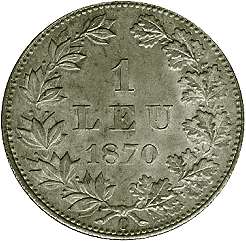
|
1 leu 1870 |
|

| 
|
|
23 mm diameter, 5 g, silver 83.5%, copper 16.5%, grained edge, outer pearl circle denomination "1 LEU" and year 1870 inside a wreath formed by a laurel branch (left) and an oak branch (right); below the ribbon that ties the branches lies the initial C standing for engineer C.J. Cândescu, the organizer and first director of the Bucharest mint | inscription "CAROL I DOMNUL ROMANIEI" meaning "PRINCE OF ROMANIA" and CAROL I head facing left, outer pearl circle Mintage: 400.000 coins |
This is the first 1 leu coin struck in Romania. The coins were struck at the Bucharest mint starting with February 24th 1870. Accordingly to monograph "Monede și bancnote românești" there are pieces with sides facing either commonly (inverted) or the medal fashion (upright). There are also pieces featuring the Bucharest mint ensign, letter B. In the monograph "Monetele României" (Coins of Romania, by Octavian Iliescu and Paul Radovici, Editura Enciclopedică, Bucharest, 2004) the 1 leu 1870 B is not a regular coin but an essay. The pattern could be seen on a dedicated page.
Mr. Cristian Ciuplea informs us that the pieces with B are extremely rare.
The pictures above are present on Romanian coins through the kind permission of Mr. J.M..
One may figure how much was such a piece worth noting that in 1868 a student scholarship rose to 37 lei, money with which the student could barely sate oneself once a day. In 1873 the scholarship was raised to 60 lei.
The name leu originates in the design of the taler (leeuwendaalder in Dutch, a.k.a. löwentaler or lion-taler) holding 75% silver alloy, weighing 27 grams, struck in the northern region of the Low Countries since 1575; the last were struck in 1713. The first lion-taler appeared in the times of the rebellion against the Spaniards and pictured on one side the image of a rampant lion, the coat of arms of the Netherlands (the United Provinces). These talers were struck for many years and were issued by many Dutch provinces and cities, e.g. Dordrecht, Deventer, Kampen, Utrecht and Zwolle. The Dutch talers were used on a large scale in the commercial relations with the Levant.
These coins got to be called lei (plural for leu - lion) as the coat of arms pictures a lion. The coin was so wide spread in our parts of the world that the coat of arms of the Netherlands pictured on it brought the name of leu (lion).

| 
|
|
40.8 mm diameter, 26.4 g, silver 75%, knight wearing helmet with panache and cloak, at his feet shield with a rampant lion on it; between an inner and outer circle the inscription MO·ARG·PRO:CO· FOE·BELG·TRA | rampant lion; between inner and outer pearl circle the motto of the United Provinces of Netherlands and the year in which the coin was struck: CONFIDENS·DNO·NON·MOVETUR·1639· |
About the legends that appear on the Dutch lion-taler
The legend MO[NETA] ARG[ENTEA] PRO[VINCIARUM] CO[N]FOE[DERATUM] BELG[ICARUM] TRA[IECTUM] means, in a free translation, "silver coin of the province of Utrecht from the Netherlands Confederation". The Latin name of the city and of the province of Utrecht is Traiectum ad Rhenum, meaning a crossing on Rhine River. The reference at Belgium appears because the territories of the Netherlands belonged in antiquity to the Roman province Belgica.
The motto of the United Provinces, CONFIDENS D[OMI]NO NON MOVETUR, can be freely translated by "those who trust in God shall not be moved. It could be an allusion to the struggle of the Dutch people under the rule of William of Orange against the Spaniards.
In the Romanian Principalities these talers were very wide spread in the 17th century. At the end of the Middle Age leul (the lion) has turned into an account unit worth 40 paras (Turkish currency) and is still preserved till the present day. The law of 1867 stated that the leu is the national currency of Romania, divided into 100 bani (singular "ban"). Ban translates as "coin", however historicaly the name is originates in the currency issued by the Banate of Slavonia in the XIIIth century.
The Republic of Moldova (Romania's neigbour to the east), which is also a Romanian state, has since 1992, naturally, the same currency - leu, lei. To be told apart, this currency is called Moldavian lion.
The Bulgarians have the same lev, leva - lion, lions in Bulgarian. Some peoples believe that Albania inherited in the same fashion the name of its currency - lek, leka -, meaning lion in Albanian. (Another ethymology derives the lek from the name of Alexander the Great, Leka i Madh in Albanian).
|
Back to selection page!
|